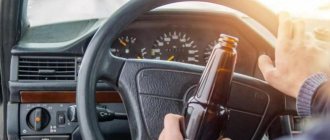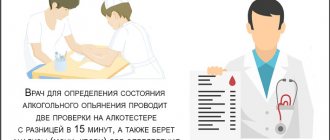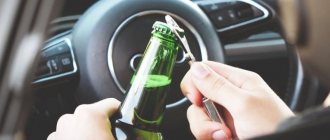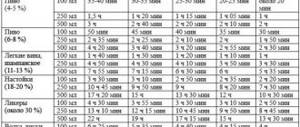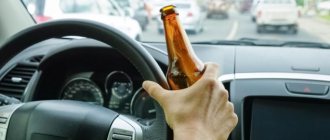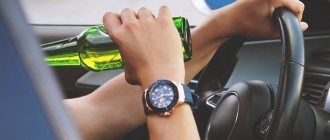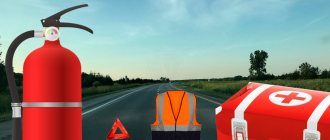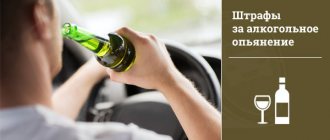Blood alcohol level
What is ppm? This is one thousandth of something, it equals 0.1%. If they say that there is 1 ppm of alcohol in the blood, this means that in a liter of blood 0.1% ethyl alcohol is 1 gram.
Degrees of intoxication and number of ppm. Doctors use this table:
| Degree of intoxication | Alcohol in blood, ppm |
| light | 1-2 |
| average | 2-3 |
| heavy | 3-4 |
| "alcohol coma" | 4 and above |
Period of complete elimination from the body in hours. The rate of elimination of ethyl alcohol from the body is on average 0.1-0.2 ppm per hour. The speed is affected by the following parameters: height, weight and gender. For example, 100 ml of vodka after 6 hours will not leave any traces in the body of a man weighing 80 kg and height 175 cm.
How many ppm are allowed while driving in 2021
The law does not punish the driver if less than 0.16 milligrams of alcohol, or 0.3 ppm, is found in a liter of exhaled air. This is how much alcohol will remain in the body of a man weighing 80 kg after 4.5 hours if he drinks 500 ml of beer with a strength of 5%. This is the answer to the question “how many ppm is allowed in 2021”.
If the check shows more, the driver will most likely be deprived of his license.
In Latin, permille literally means “per thousand.” This is one thousandth or one tenth of a percent.
This unit is designated “‰” and serves, among other things, to determine the amount of alcohol contained in:
- blood;
- urine;
- vapors exhaled by humans.
The ratio between milligrams per liter and ppm is 0.45.
1 ‰ = 0.45 mg/l.
The period of weathering of alcohol from the body is quite long.
Some averages:
| Name | Fortress | Time | Drink volume | Human weight |
| Beer | 4-6o | 30-40 min | 100 g | 80 kg |
| Champagne | 11o | 1 hour 15 minutes | ||
| Vodka | 40o | 4 hours 20 minutes | ||
| Cognac | 42o | 4 hours 40 minutes |
Just feeling that a person has already sobered up is not enough. The test may not be in his favor.
How to check your blood alcohol level
A drunk driver is a danger to himself and to other road users. It is precisely because of the increased danger that the punishment for such citizens is especially severe, and the government, by a separate order, approved the rules for testing drivers for intoxication. Here are the main points.
Reasons for checking. If the inspector has reason to believe that the driver is drunk, he will send him for a medical examination. Reasons are one or more signs of driver intoxication:
- smell of alcohol from the mouth;
- stands unsteadily;
- speaks incoherently;
- the face quickly turns red or pale;
- behaves inappropriately to the situation, for example, waving his arms and shouting.
On-site inspection. The driver is told the testing rules and is asked to exhale into a special device - a breathalyzer. The driver can get out of his car, but is not required to. The inspector knows how many ppm you are allowed to drive in 2021, and therefore can send you for a re-inspection.
Re-check. If the device detects at least 0.16 milligrams of alcohol per liter of exhaled air, the driver will be asked to blow into the tube again after 15-20 minutes.
Protocol. If during the second test the device again shows the same result, the driver will be declared drunk and a report will be issued about this. The inspector will send this protocol to the court. If the breath alcohol tester does not show any results, the driver will be released.
Check with a health worker. A driver will be sent to be checked at a medical facility or mobile medical examination center if he:
- refused on-site inspection;
- does not agree with the results shown by the inspector’s device;
- still drunk according to the inspector. This is possible if the device has been in the cold for a long time or, in the opinion of the inspector, is faulty.
The health worker will test the exhaled air and military materials - urine and blood - for alcohol.
If the driver is found to have alcohol, the medical worker makes a note about this in the report - the traffic police officer attaches this document to the protocol and sends it to the court.
In all cases where the test results show that the driver is drunk, the car is sent to the impound lot. Let us remind you that the permissible amount of ppm in exhaled air in 2021 is 0.3.
Falsification of tests. Some drivers try to give the doctor fake urine or dilute it with water. At mobile and stationary urine testing points there are special booths where drivers make the change.
But doctors check temperature, acidity, density and several other parameters that allow them to establish the fact of falsification. If the health worker discovers this, he will make a note about it in the report.
Substitution according to the law is equal to refusal of examination. And the punishment for this is a fine of 30,000 rubles with deprivation of rights for up to 2 years.
More modern breathalyzer models have a miniprinter - it prints the test result. The inspector will attach this printout to the protocol. Source: draeger.com
Permissible norm in 2013 - 2018
From September 1, 2013 until July 3, 2021, the edition of the Code of Administrative Offenses was in force, containing the following note to Article 12.8:
Note. The use of substances that cause alcohol or drug intoxication, or psychotropic or other intoxicating substances is prohibited. Administrative liability provided for by this article and part 3 of article 12.27 of this Code occurs in the event of an established fact of consumption of substances that cause alcohol intoxication, which is determined by the presence of absolute ethyl alcohol in a concentration exceeding the possible total measurement error, namely 0.16 milligrams per liter of exhaled breath. air, or in the case of the presence of narcotic drugs or psychotropic substances in the human body.
Thus, the permissible level of alcohol in the driver’s exhaled air was 0.16 mgl or 0.356 ppm .
How to appeal the results of an inspection
Errors in the protocol. If the case goes to court and the driver has arguments in his own defense, he can report errors when drawing up the protocol:
- there were no witnesses or video recording of testing;
- the information in the document does not correspond to the facts, for example, the driver’s words are distorted;
- Incorrect data: names, dates or places.
Errors in testing. During testing, the driver is required to exhale into a special tube that is attached to the breathalyzer itself - a mouthpiece. The inspector should only use a new tube - remove it from its sealed packaging. This is necessary so that after the previous inspection there are no traces of saliva or alcohol left in the tube, and also to exclude forgery on the part of the inspector.
If the driver notices that the mouthpiece is already on the device, he must insist that this fact be recorded in the protocol.
Modern breathalyzers are equipped with a mini-printer - the driver must pay attention to the data in the printout, which the inspector will attach to the protocol. If it does not contain today’s date or the readings are clearly exaggerated, you need to mention this in the protocol or not sign the document at all. Inflated readings, for example, are as follows: the driver drank a mug of weak beer, but the device shows that he drank a bottle of vodka - this is 2.5 ppm. This is much higher than the ppm allowance for driving in Russia in 2021.
Also, at the driver’s request, the inspector must show documents for the breathalyzer, indicating that the device is registered and in working order. To check whether the device is registered, you need to go to the website of the register of approved measuring instruments and enter “ethanol” in the “Name of measuring instruments” column.
Next, through the search on the page, find the word “exhaled” or words similar to it. Search on a page - keyboard shortcut Ctrl+F on Windows or ⌘+F on Mac
As a result, you will find information about all registered devices. If the test was carried out with a device that is not registered, this will help to challenge the data from the protocol.
If the driver wants to retest the blood and urine, for example, in a private laboratory, he can do this - the samples are stored in the medical institution for three months. And the results obtained using special devices last for 5 years.
In any case, when the driver does not agree with the verification procedure, he has the right not to sign the protocol.
FAQ (frequently asked questions)
- What is the acceptable ppm value for 2021?
The legal blood alcohol limit for 2021 is 0.16 mg/liter for breath and 0.35 (0.3 g/liter) for a blood alcohol test. Such standards are established in Article 12.8 of the Code of Administrative Offenses, which is regulated by Federal Law No. 62 of 2021.
- Does the traffic police inspector need grounds to conduct an inspection, can I refuse?
According to the Administrative Code, the traffic police inspector makes a decision to check the driver’s condition at his own discretion, taking into account a visual assessment of his behavior. You may not agree with the results of the review, but you cannot refuse. If you refuse an inspection, as well as a medical examination, you are subject to a mandatory administrative penalty - a fine of up to 30,000 rubles with the deprivation of your driver's license for 1.5-2 years and the car being sent to an impound lot.
- What should I do if I do not agree with the result of the review?
You must state your disagreement and ensure that your refusal is reflected in the record. After 15-20 minutes, you should repeat the breathalyzer test. It is also recommended to agree or independently offer to the inspector to take you for a medical examination.
- Can a breathalyzer show an excess of ppm if I drank kefir or kvass before a trip?
A breathalyzer may show an increased blood alcohol content if you drank kefir or kvass immediately before the trip. However, this figure is unlikely to exceed the permissible norm. In addition, an increase in alcohol can be caused by yeast baked goods, yoghurts, fruit juices and overripe fruits, chocolate and tobacco, as well as some medications (for example, Corvalol, Valocordin, etc.) and chronic diseases.
In conclusion, we note that even if Russian legislation has a permissible level of alcohol content in the blood of a driver. For the driver of a car, these standards are minimal and actually do not allow the consumption of alcoholic beverages. “The permissible ppm levels (1.6 mg/l in the breath and 0.35 in the blood test) exist in order to exclude erroneous punishment of citizens whose elevated alcohol content is not related to the alcohol they drank.
Fines for drunk driving in 2021 have been significantly increased, and criminal liability has been significantly tightened. Therefore, there is no need to solve the problem of how and in what time to reliably remove alcohol from the blood - it is better to stop drinking alcohol so as not to create problems for yourself and other road users.
Is it possible to mitigate the punishment or fine?
The judge may impose a minimum term of imprisonment of 1.5 years instead of 2 years.
Alexander Torvard, car lawyer For drunk driving, in addition to a fine, there is a “delta” of penalties - a period of deprivation of rights from 1.5 to 2 years. When determining the term, the judge will take into account mitigating and aggravating circumstances. Mitigating factors include, for example, remorse, the presence of dependents and the absence of previous violations. These circumstances cannot completely exempt you from liability. Aggravating circumstances include repeated violation of the law under the same article of the code or unwillingness to admit to the crime.
Any amount of alcohol is a violation
Driving while intoxicated is strictly prohibited. Despite this, the law establishes the norm for the alcohol content in human blood.
The device for measuring ppm has some error, so its indicator almost never shows zero alcohol content. The ppm standard was established not to allow the driver to drink alcoholic beverages, but to take into account the small amount of alcohol contained in some food products. These products include:
- Kvass, kumiss and other non-alcoholic drinks (including 0% beer) obtained by fermentation.
- Rye bread.
- Some fruits and berries are overripe (banana, orange, etc.).
- Fermented milk products (kefir, yogurt).
- "Baba" bun.
- Sweets with liqueur or cognac.
Cigarettes contain 0.2 ppm of alcohol and mouth fresheners contain 0.4 ppm. Medicines and tinctures (valerian, motherwort, etc.) contain approximately 0.1 ppm.
You should not rely on the permissible ppm rate: it is provided for food and is so low that even a small glass of alcohol will not fit into this framework. Drunk driving in Russia is punishable by a fine of up to 30 thousand rubles and deprivation of rights for up to two years.
Remember
- The amount of ppm alcohol allowed in 2021 is 0.3 ppm in exhaled air.
- The inspector has the right to check the driver if he cannot stand, speaks incoherently or behaves inappropriately.
- The driver may not agree with the test results and insist on medical testing.
- If you refuse to check completely, the law will equate it to drunk driving.
- If the driver does not agree with the results of the check, he can reflect this in the protocol or not sign the protocol at all. Then you will have to prove your case in court.
- If alcohol is detected above the ppm alcohol limit in Russia in 2021, the driver will be deprived of his license for up to 3 years and fined 30,000 rubles.
- A mitigation of the punishment is possible - the judge can reduce the period of deprivation of rights to 1.5 years.
All articles by the author: Evgeniy Lesnov
What determines the alcohol content in the blood and exhalation?
By and large, the amount of alcohol in the blood and exhaled air is determined by the volume and strength of the drink, the quality of the snack, the time of the last intake and the individual characteristics of the body. First of all, metabolism and the speed of reactions, that is, metabolism. It depends on your physical condition, age and gender.
Alcohol that enters the stomach and intestines is not absorbed into the blood equally quickly in everyone and is excreted differently. Some of the alcohol does not enter the blood: with an empty stomach - approximately 10%, with a full stomach - 30%. On average, 100 g of vodka is digested in one hour, champagne and beer come out faster. It takes 10 hours to eliminate 1.5 ppm of alcohol from the blood. A citizen with a concentration of 3 ppm in the blood will sober up no earlier than after 20 hours.
The liver is responsible for metabolism, thanks to which ethanol is oxidized to acetaldehyde, and then to acetic acid. A healthy organ is capable of processing up to 10 grams of pure alcohol per hour. The blood washes the lungs, into which alcohol also enters. That is why we feel the unpleasant smell of alcohol, and then fumes (traces of processing) from the drinker. The worst thing is that alcohol enters the brain, where its concentration can be 75% higher than in the blood.
Penalties
Driving a vehicle while intoxicated or transferring control of a personal vehicle to a drunk driver is punishable by a fine of 30,000 rubles and deprivation of rights for 1.5-2 years. In this case, you will have to pay for parking services (about 1000 rubles per day) and a tow truck (about 2000), which will deliver the car there.
Remember! Driving while intoxicated without documents or after deprivation of the right to drive a car entails arrest for up to 15 days or an administrative fine.
If within a year after returning the driver’s license she is again detained under the same article, the fine will increase 10 times and amount to about 300 thousand rubles. Depending on the situation, he may also face deprivation of his license for up to three years or imprisonment for up to 2 years. Repeated driving is also considered at any stage of intoxication until the documents are returned.
The punishment is determined not only by the degree of intoxication, but also by the consequences and other aggravating circumstances. For example, an accident in which a pedestrian or several people are hit is dealt with in accordance with the provisions of the criminal code, and the penalty for imprisonment depends on the number of victims and the degree of damage to their health.
Fine for driving while intoxicated
If the check shows that the driver drank alcohol, he will receive a fine of 30,000 rubles and deprivation of his license for up to two years. If you refuse a medical examination, the punishment will be the same.
